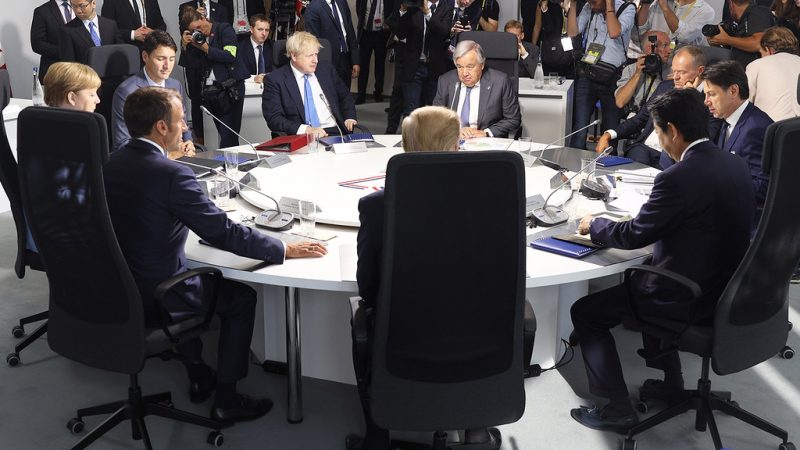Corporations could find it easy to dodge the G7's proposed new tax rules.

Prem Sikka is an Emeritus Professor of Accounting at the University of Essex and the University of Sheffield, a Labour member of the House of Lords, and Contributing Editor at Left Foot Forward.
The G7 countries’ agreement to tax footloose global capital has received universal praise.
But while any attempt to ensure that corporations pay their fair share of taxes is welcome, this agreement has a large number of hurdles.
The agreement
The discussions about taxing multinational corporations have been going on for many years, often under the umbrella of the Organisation for Economic Co-operation and Development (OECD).
Its Base Erosion Profit Shifting (BEPS) project produced a number of recommendations which have had limited success in curbing tax avoidance. Nation states have quibbled over the right to tax global tech companies. Some have threatened to unilaterally impose taxes which could violate the taxing rights of other countries. Tax wars loomed.
The rebuilding of post-Covid economies requires revenues and, under Biden administration, the debate has morphed into levying a minimum tax rate on multinational corporations. Indeed, the US has threatened to impose tariffs on imports from countries levying digital services tax (DST) on technology companies originating from the US.
The G7 agreement refers to the US, UK, Germany, France, Canada, Italy and Japan. The agreement is in two parts. Under Pillar One, profitable multinationals will be required to pay tax in the countries where they operate – and not just where they have their headquarters. The rules would apply to global firms with at least a 10% profit margin – and would see 20% of any profit above the 10% margin reallocated and then subjected to tax in the countries they operate.
Under Pillar Two, the G7 agreed to the principle of at least 15% global minimum corporation tax operated on a country by country basis.
The nation states will continue to set the corporate tax rates that they feel are appropriate. The key idea is that if a company pays a lower rate of tax, local government can then top-up the tax charge to an internationally agreed minimum rate.
The US originally advocated a minimum tax rate of 21%, but settled on “at least 15%” to broker an agreement. The UK has capitulated and the government has said it will “remove the UK DST once a Pillar One solution is in place”.
Fraught finance
The G7 agreement is a starting point and needs considerable detail and clarification. The arbitrary threshold of a profit margin 10% can enable many corporations to escape the minimum rate of tax. They may indulge in ‘intragroup’ transactions to shift profits to low/no tax, and artificially lower their profits.
There is a concern that the minimum rate may become the de facto tax rate for multinational corporations. However, all corporations are likely to be affected. Many smaller businesses lack mobility and may end up paying a higher rate of tax than bigger corporations.
The agreement is silent on the tax base – what is to be taxed at the rate of 15%. There are many ways of calculating taxable profits. For example, in the US inventories are valued by a using a method known as Last In First out (LIFO), whereas in much of Europe, they are valued by using a method known as First In First Out (FIFO). Each method produces materially different taxable profit. Inevitably, the tax base needs attention.
The agreement does not say what role various government incentives will play in calculation of the tax base. For example, the UK gives tax subsidies for research and development and many other types of expenditure. This lowers taxable profits and may be used to attract corporate investment and undermine the tax base of another country. So agreement would be needed on whether the tax base is the profit before or after various tax incentives.
Artful dodgers
The current rules for taxing corporations facilitate tax avoidance. For example, they assume that each subsidiary of a company is an independent taxable person. So if Google has 500 subsidiaries, each is considered to be an independent taxable unit.
This gives them incentives to lower taxes by shifting profits through intragroup transactions to low/no tax jurisdictions. The G7 agreement does not seem to negate profit shifting, though it talks about allocating 20% of any profit above the 10% margin to countries where multinationals operate. A formula for the allocation would be needed.
Another approach would treat Google, regardless of the number of subsidiaries, as just one integrated company. After all, it has a single board, a share price, one logo and business strategy and intragroup transactions make no difference to its underlying economic reality.
Under this approach, Google’s global profits would be consolidated and allocated to each country of its operations in accordance with an apportionment formula. Such an approach is favoured by the EU and has considerable capacity to check profits shifting to low/no tax jurisdictions.
The G7 countries hope to enrol others. So the agreement will be discussed at the G20 Finance Ministers’ meeting next month. After that, the OECD could be asked to develop details, followed by approval of parliaments of relevant countries.
That could take several years – and it would still leave unsolved the pressing problem of tax dodging by trusts and wealthy elites.
Image credit: No 10
To reach hundreds of thousands of new readers we need to grow our donor base substantially.
That's why in 2024, we are seeking to generate 150 additional regular donors to support Left Foot Forward's work.
We still need another 117 people to donate to hit the target. You can help. Donate today.



